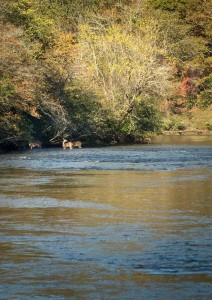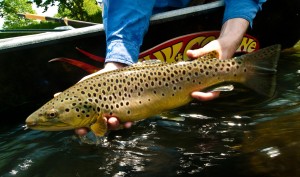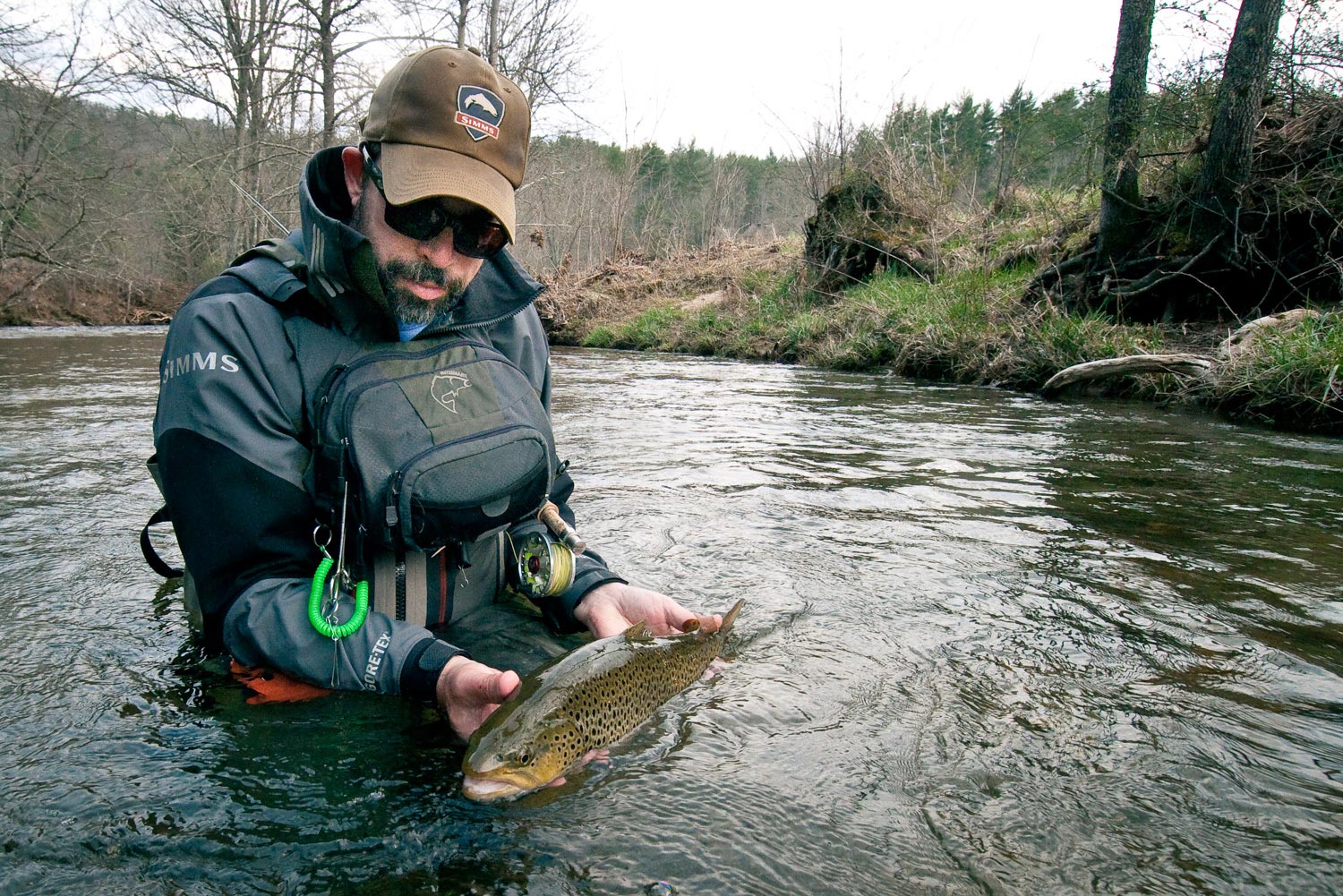By Jason Tucker
The time has come in my life where I want to expand my horizons. I want to light out, free myself from the confines of my routine, my local area, my set habits.
It’s true that there are still many rivers, runs, hatches and fisheries I have yet to explore in my native Michigan, but the world is a big place. There’s a lot of water out there. While there are worse things in life than exploring Michigan’s water, it would be a shame to go through life without experiencing other places.
My interests and aspirations are as varied as classic Western fishing in Wyoming, Idaho and Montana, or remote brook trout in Labrador and Ontario, to bonefish on the flats of the Bahamas and Oahu. Somewhere in the back of my fantasies lurks one fish, the permit. That may be a bit down the pike, but someday. I hope.
I recently had the opportunity to get out of Northern Michigan for a few weeks and head south, get out of the cold for a while. This winter isn’t as bad as the last, but it’s still pretty bad.
I got the invitation to go spend the winter in Georgia with friends, and so I took them up on it. The problem is that they are not fly fishing friends, a character flaw that I had to overlook. A big draw for me was the idea of being able to explore new water that is fly-fishable year round. I’ve never caught a trout on a dry fly in January and the thought appealed to me.
For me Georgia is a blank slate. I know they have trout streams and even some native brook trout in the northern mountains, but I personally associate the south with catfish, bream and bass, not fly fishing for trout. I arrived with no ideas, no notions of what the fishing is like, no compass. This appealed to me– the sheer raw adventure of exploration, taking that blankness in my mind and attaching experiences and names to it, fleshing out a map all my own of a new place. Never mind that Georgia has been inhabited by European immigrants for over 400 years; it was all new to me, which is what matters, and the exploration is new to me.
I arrived in Georgia sight unseen, meaning I had zero time to do any research before I came.
 I have never spent any extensive time in the South. It certainly is different from my home. I love the fact that even some of the gas stations sell fresh homemade biscuits. I’ve tried boiled peanuts for the first time ever. I have yet to find any good barbecue, but there is still time for that.
I have never spent any extensive time in the South. It certainly is different from my home. I love the fact that even some of the gas stations sell fresh homemade biscuits. I’ve tried boiled peanuts for the first time ever. I have yet to find any good barbecue, but there is still time for that.
It is great coming to a new place, not just a different version of where you live, but a place that has its own culture, history, unique accent, terrain and vibe. The trees are different, the terrain is different, the climate is definitely different, and the fishing, I expect, is different.
Despite the sense of adventure the very large question looms– when in a new place, how do you find good fishing? Where do you start? How does one take in the vastness of a state and make sense of it all?
I started with a three-pronged approach.
First I used my social media network to contact a friend in Georgia– in this case Gink and Gasoline’s own Louis Cahill. You have to be careful when you do this, particularly if you don’t know them personally. I tried to make it clear that I wasn’t asking for honey holes or secret information. I was just hoping to be pointed in the right direction and get a feel for the fishery, what to expect, what to avoid, what to be prepared for.
To his credit Louis got back to me, was far more generous with information than I normally expect from people, and even offered to take me out fishing. I was of course, quick to say yes.
Summary:
Work social media or other contacts if appropriate- be polite, not demanding. Most anglers are proud to rep their water and glad to point you in the right direction. I should point out that I have done this for others on multiple occasions. You’ll be surprised at how much good information gets offered up.
Look up the state website and read through all the available information.
Find the local fly shop, pay them a visit, ask questions and pay attention to their answers.
Put it all together, get out there, explore and FISH!
If you don’t have the time for all this consider hiring a guide.
My next step was to go to the state website. I wanted to get a feel for the regulations and fishery. States have a vested interest in promoting their fisheries, and Georgia offers an abundance of information on seasons, water that is open year round, delayed harvest water (stocked water open to fishing but closed to harvest), and even access.
My next step was to do an internet search of local fly shops. After clicking around a bit I settled on one. They were an hour and a half away up in the mountains, and I didn’t mind the drive and the chance to explore. I drove north through the rolling Piedmont down the narrow roads, past farms, pecan and oak forests, and Indian burial mounds.
I pulled into the gravel lot at the shop and got out. Inside I was greeted by Jake. He was friendly, knowledgeable and helpful. The first thing Jake did was pull out a trout stream map produced by the state of Georgia. It details all of the trout streams and color codes them according to season and even stocking. Jake proceeded to highlight various stream sections that were open with advice on when to fish them. He even jotted down pertinent stream flow information, being that this is TVA country and knowing water levels and dam releases can be the key difference between a great day on the water or a day spent flogging.
After that I had two very lengthy telephone conversations with Louis Cahill. He downloaded more information to me in those conversations than I could have learned in two years of fishing. I did my best to jot notes down and scribble on my map, but we were driving at the time and so I’m sure I missed a lot.
There was one location that both Fly Shop Jake and Louis recommended, and so I went for a drive on a Saturday afternoon to go check it out. Business at home was calling me away, but I at least wanted to scout out the drive and the water. I drove north into the mountains, past yet more farms, small towns, and deeply cut rocky gorges.
Once we reached a town set in a valley between steep sided mountains we turned east and followed a winding, narrow paved road. We wound our way twenty miles into the mountains before finding the bridge we were looking for. We parked at the lot and wandered down to the water’s edge. Clear greenish water flowed over brightly colored stones. A few fishermen dredged nymphs through the runs upstream. We didn’t have long, and I wasn’t there to fish; just there to check it out, enjoy the drive and the scenery.
 Fast forward two weeks and I’m on the river with Louis and his friend Brad. We’re drifting the Toccoa River in his Adipose skiff. Due to maintenance at the Blue Ridge dam the river is barely flowing. The morning dawns cold and frosty, but as the water warms we start to see fish. Two very respectable rainbows come out to chase my black streamer, and at a creek confluence a two-foot long brown trout comes out to chase Brad’s fly. Later in the day I hook up on a small teener rainbow but it shakes the hook near the boat.
Fast forward two weeks and I’m on the river with Louis and his friend Brad. We’re drifting the Toccoa River in his Adipose skiff. Due to maintenance at the Blue Ridge dam the river is barely flowing. The morning dawns cold and frosty, but as the water warms we start to see fish. Two very respectable rainbows come out to chase my black streamer, and at a creek confluence a two-foot long brown trout comes out to chase Brad’s fly. Later in the day I hook up on a small teener rainbow but it shakes the hook near the boat.
Later, of all the magical things, it warms to the point that caddis begin to hatch, and shortly thereafter we see our first rises. We go on to land several small rainbows on dry flies, stockers to be sure, but it still felt great to cradle a trout once again before sending it on its way.
A few days later I went back into the mountains, alone this time. I hiked in to an X on a map, where cold green water coursed over colorful stones. I waded in, stripped out forty feet of line and waited. After a few minutes a single trout rose and broke the surface.
Jason Tucker Gink & Gasoline www.ginkandgasoline.com hookups@ginkandgasoline.com Sign Up For Our Weekly Newsletter!


Jason, the best fly fiy fishing in Georgia is in North Carolina!
Hey Jason,
Good advice in talking to the local fly shop, or getting to know a local/ guide first. Can save alot of frustration and shorten the learning curve immensly.
I guide for those big brookies in Northern Ontario your talking about, on the Nipigon river. One of the biggest things I see when fly fisherman show up is they come undergunned with the gear they bring. Expecting to catch a monster brook trout on a #12 dry on a massive, deep river. They dont get that big eating insects!
Great article Jason, really enjoyed it!
My first thoughts as I read the article was “this is a bad case of the lack of the 7Ps”
That is “Proper Prior Planning Prevents Piss Poor Performance”.
And I haven’t changed my mind
Bruce, I agree. Those “P’s” were drilled into me as a youngster to make me realize that “Practice does not make perfect. Practice makes permanent”.
Mine were just a bit different:
“Prior Proper Planned Preparation Positively Prevents Piss Poor Performance Permanently ”
I was going to have those ten “P” words tattooed on my pecker so I would see them all the time as a reminder, but your seven words seem just as effective and will be less painful and will fit a lot better.
Thank you. Tight lines.
Jason is a great writer and can even do more magical things with a keyboard than he did here. I loved getting his pieces over at The Cedar Sweeper and still love reading them now.
The great thing about fly fishing is every time you look up, there is another bend in the river.
Pingback: Weekly Review |
Pingback: Fishing New Water - News WordPress theme
Pingback: Fishing New Water | MidCurrent
why did you limit space to streams? Warm water Fisheries in Georgia for Bass and bluegill or world-renowned. You missed a great opportunity just as many do in Texas.
Pingback: Fishing New Water – BestFitnessDirect